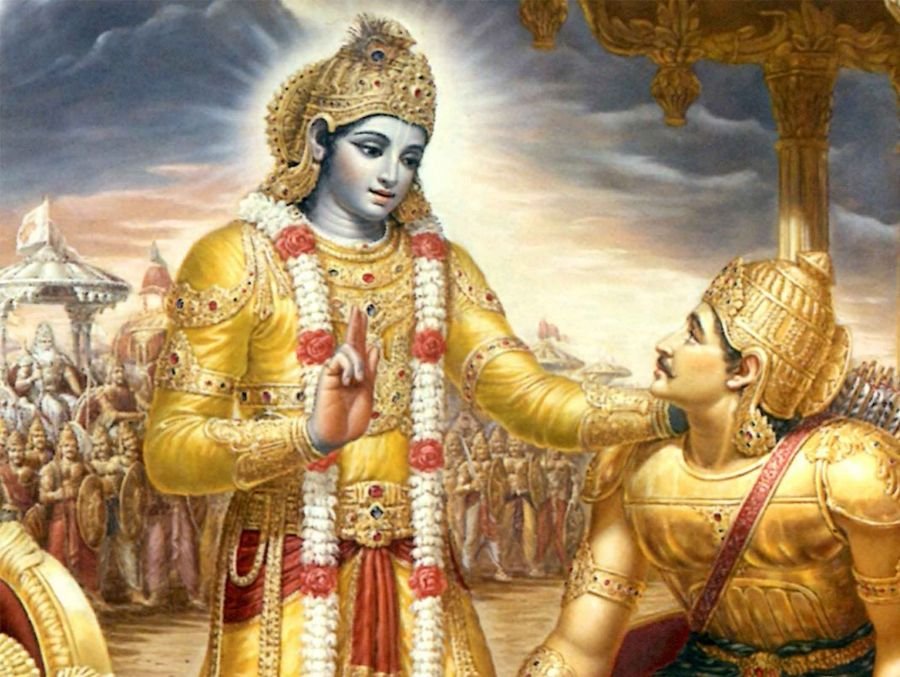(Image Courtesy Mahanidhiswami)
God Is Time Himself, And He Is Also The Destroyer
श्रीभगवानुवाच |
कालोऽस्मि लोकक्षयकृत्प्रवृद्धो
लोकान्समाहर्तुमिह प्रवृत्त: |
ऋतेऽपि त्वां न भविष्यन्ति सर्वे
येऽवस्थिता: प्रत्यनीकेषु योधा: || 11.32||
śhrī-bhagavān uvācha
kālo ’smi loka-kṣhaya-kṛit pravṛiddho
lokān samāhartum iha pravṛittaḥ
ṛite ’pi tvāṁ na bhaviṣhyanti sarve
ye ’vasthitāḥ pratyanīkeṣhu yodhāḥ|| 11.32||
Shloka Translation
BG – Ch. 11- Ver. 32:
I am time, the seasoned annihilator of universes, engaged in eliminating all these individuals, stated Shree Bhagavaan. All those hostile soldiers will vanish in the future without your (effort).
Explanation
Shree Krishna reveals his true nature as all-powerful Time, the universe’s destroyer, in response to Arjun’s enquiry about who he is. The term kala comes from kalayati, which is a synonym for ganayati, which means “to count.”
All natural events are buried in time. All beings’ lives are counted and controlled by time. It will determine when renowned figures such as Bheeshma, Dronacharya, and Karna would pass away. Even without Arjun’s participation, it will destroy the enemy army on the battlefield. Because the Lord intends for it to happen as part of his big plan for the world.
Verse & what we can learn
Shri Krishna appeared to Arjuna in his cosmic form, revealing himself and his goal to destroy the cosmos and all living entities within it. Shri Krishna claimed to be “kaala,” which implies both time and death.
They both signify the same thing because everything expires over time. He also used the term “pravruddha,” which means “mature” or “seasoned,” implying that he was well-versed in the process of devastation and that it wasn’t a one-time occurrence.
Because our minds operate within the confines of space and time, understanding what Arjuna witnessed is challenging. He most likely witnessed the past, present, and future all unfolding at the same moment.
Shri Krishna was able to show Arjuna the future through this vision. The Mahabharata war was over, and just a few Kaurava warriors remained alive. In other words, Shri Krishna had determined that the Pandavas would win the fight. They fought like any other army, but Shri Krishna did the real work behind the scenes.
Shri Krishna teaches us about humility. He exposes that he is the one in charge at the end of the day. If he wants to do something, he’ll do it with whatever tools he has at his disposal, whether it means instilling a thought in one person or a million.
When we hear this, we might wonder why we should do anything at all because Ishvara is in charge of everything. Arjuna was probably thinking the same thing. He would have questioned why he was fighting, echoing the point he made in the first chapter when we wished to escape the war.
To acquire knowledge and to implement that knowledge in life one needs to be mentally and physically active and healthy and for that daily meditation is a great tool.
There are various types of meditation like Buddhist meditation, heartfulness meditation, mindfulness meditation, meditation for stress, and each meditation benefits are countless. There is also numerous meditation techniques for beginners which help in practicing daily meditation so go ahead and start your journey towards a peaceful and balanced life.
In the next shloka Shri Krishna asks Arjuna to fight the war.
Let’s learn to live with “The Gita” via Meditation Affinity…
